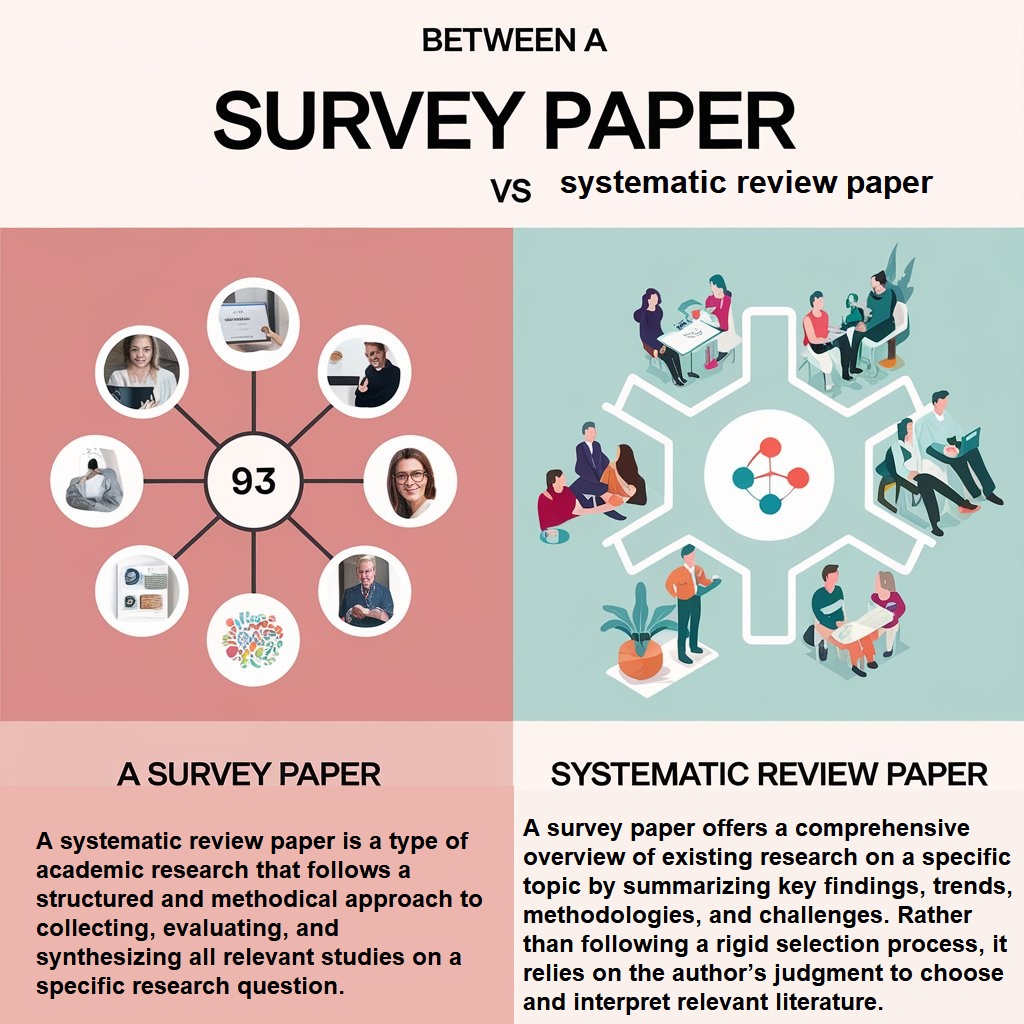Larity and precision are everything when it comes to understanding the types of papers scholars use to analyze existing literature. Two commonly confused formats are the survey paper and the systematic review paper. At first glance, they might seem similar, as both aim to synthesize knowledge in a specific field.
However, they serve distinct purposes and follow different methodologies. Understanding these differences is crucial whether you’re a student embarking on a literature review or a researcher choosing the correct format for your work. In this blog, we’ll break down what sets a survey paper apart from a systematic review, highlight their unique goals, and help you determine which best suits your research needs.
What is a survey paper?
A survey paper offers a comprehensive overview of existing research on a specific topic by summarizing key findings, trends, methodologies, and challenges. Rather than following a rigid selection process, it relies on the author’s judgment to choose and interpret relevant literature. The goal is to give readers a general understanding of the research landscape, making it especially useful for those new to a subject area. Survey papers often highlight significant contributions, identify research gaps, and suggest future directions. Because of their broad scope and flexible structure, these papers are commonly used to map out the current state of knowledge in a field without being bound to systematic criteria.

What is a systematic review paper?
A systematic review paper is a type of academic research that follows a structured and methodical approach to collecting, evaluating, and synthesizing all relevant studies on a specific research question. Unlike survey papers, systematic reviews use predefined criteria to identify, include, or exclude studies, ensuring objectivity and minimizing bias. This process often involves a comprehensive search across multiple databases, careful documentation, and sometimes even statistical analysis (meta-analysis) to conclude. The primary goal is to provide reliable, evidence-based answers to focused questions, making systematic reviews highly valuable in fields like medicine, psychology, and social sciences where evidence-based decision-making is essential.
Difference between a survey paper and a systematic review paper
The main difference between a survey paper and a systematic review paper lies in their purpose, methodology, and level of rigor. A survey paper provides a broad, often narrative overview of a research area, highlighting trends, challenges, and key studies based on the author’s judgment. It is flexible in structure and may not follow a strict selection process.
In contrast, a systematic review paper answers a specific research question through a rigorous, transparent, and reproducible process, including predefined inclusion/exclusion criteria, comprehensive database searches, and detailed data analysis. While survey papers are ideal for understanding the general landscape of a topic, systematic reviews aim to provide evidence-based conclusions. They are often used to inform policy or clinical decisions.
Read on Difference between a research paper and review paper
|
Survey Paper |
Systematic Review Paper |
| Purpose |
To give a broad overview of a research area |
To answer a specific research question using evidence |
| Methodology |
Flexible and narrative-based |
Follows a structured, predefined protocol |
| Source Selection |
Based on the author’s judgment |
Based on strict inclusion/exclusion criteria |
| Scope |
Broad and general |
Narrow and focused |
| Bias Control |
May include subjective choices |
Designed to minimize bias through transparency |
| Use Case |
Introduces newcomers, maps out a field |
Supports evidence-based practice or decision-making |
| Data Analysis |
Descriptive and qualitative |
May include qualitative or quantitative synthesis (e.g., meta-analysis) |
| Reproducibility |
Low – depends on the author’s perspective |
High-quality methods are documented and repeatable |
Conclusion
Understanding the difference between a survey paper and a systematic review paper is essential for selecting the right approach to reviewing literature. While both aim to summarize existing knowledge, they serve different purposes and follow distinct methodologies.
Survey papers are ideal for exploring a broad field and identifying trends. In contrast, systematic reviews are best suited for answering specific research questions with high rigor and transparency. Choosing the right type depends on your research goals, the depth of analysis required, and the standards expected in your academic or professional field.









 Evan John
Evan John